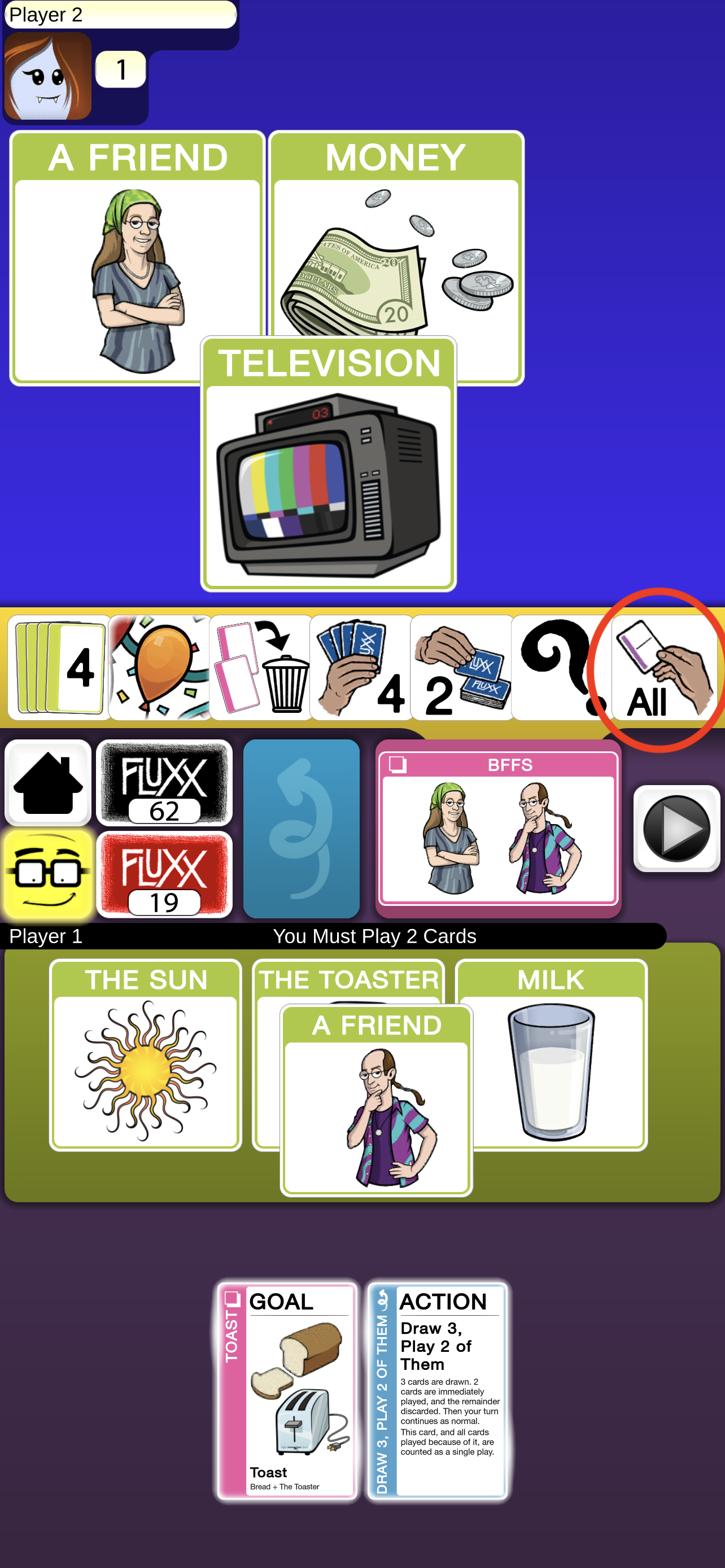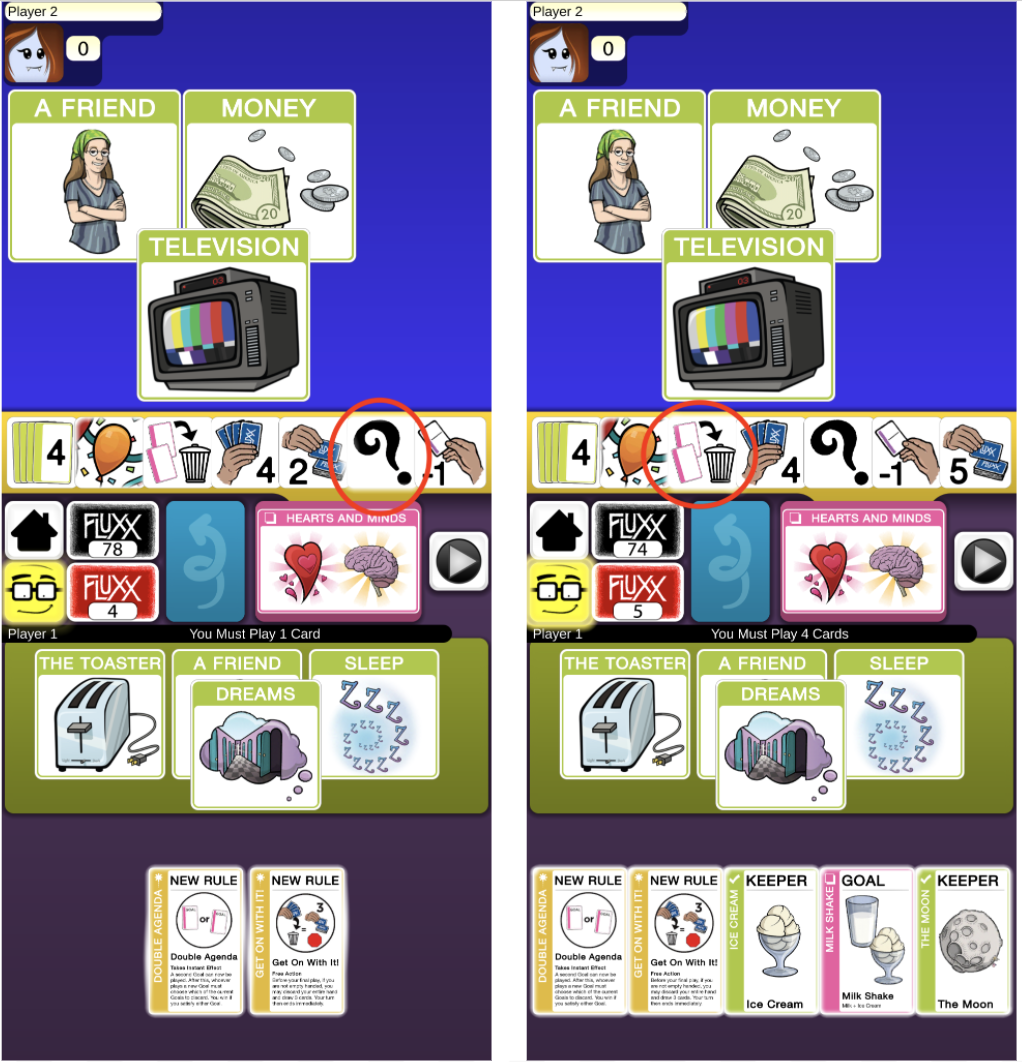FLUXX is a card game made by Looney Labs. I played the base game in both the physical version as well as the mobile version on iOS.
Formal elements:
Players: 2-6 players, multilateral competition.
Objective: Race / Capture: Be the first to play a set of cards matching the current goal.
Outcome: Zero-sum game, only 1 player can win.
Resources: Cards (4 different types: keepers, actions, goals, and new rules).
Rules:
- Players take turn drawing 1 card and playing 1 card (can be a keeper, an action, a goal or a new rule).
- When a keeper is played, it is put face up on the table.
- When an action is played, the player follows the instruction on the card.
- When a goal is played, it replaces the current goal if any.
- When a new rule is played, it is added to the set of rules of the game (and replaces any conflicting rules), which every player has to follow.
- Rules can change the number of cards drawn or played in a turn, limit the number of cards in hand, limit the number of keepers, etc.
- A player wins when they have a set of keeper cards in play that matches the current goal.
Procedures:
- Setup: Put the basic rule card in the middle of the table. Shuffle remaining cards and deal 3 cards to each player. The remaining cards become the draw pile.
- The first player draws 1 card and plays 1 card. Rotate to the next player and repeat.
- Each player has to follow all the new rule cards in play.
- If the game runs out of cards, shuffle the discarded cards and draw from that pile.
- The game continues until a player wins (when they have a set of keeper cards in play that matches the current goal).
Boundaries: the space on which the game is play (a table, or a phone if playing the mobile version).
Conflict:
- The rules create a lot of restraints (for e.g. limiting the number of cards a player can have in hand thus forcing them to discard cards), so players have to constantly make decisions that might not be directly related to their final goal.

-
- I need to discard 1 card since there is a hand limit of 2 (circled in red). But which card should I discard? None of the cards are directly related to my goal (which currently is to get 2 keeper cards, “Cookies” and “Ice cream”), but they might all be useful in the future…
- The changing rules means players need to constantly change their strategies to fit with the current rules.
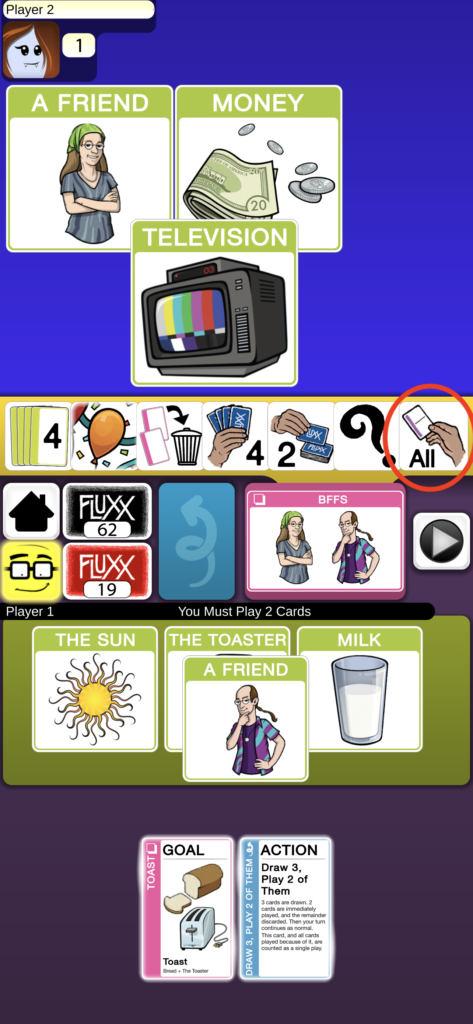
-
- My opponent plays a new rule card that forces me to play all cards (circled in red). My previous strategy was to play the “Toast” goal card that requires the “Bread” and “The Toaster” keeper cards. because I already have “The Toaster” keeper card. However, now I need to also play the action card “Draw 3, Play 2 of Them.” Now I need to consider potentially getting multiple goal cards when I “draw 3.” If I play the “Toast” goal card first, I might have to replace it with a new goal card from the cards I draw due to the action card. Therefore, I would need to supplement my strategy by playing the “Draw 3, Play 2 of Them” action card first, then play the goal card I wanted to play.
- Because there can only be 1 winner, players need to both try to reach the win state and prevent others from reaching the goal (by changing the goal, stealing others’ keepers, etc.)
- In the previous scenario, even though I also have half of the current goal because I have 1 “A Friend” keeper card, I would still be interested in changing the goal to prevent my opponent (who also has an “A Friend” keeper card) from somehow gaining another keeper card and reaching the goal before me.
Type of fun:
Challenge: The limitations imposed by the (constantly changing) rules create changing obstacles that players need to make decisions around. The player is trying to outsmart other players but also the game. I found myself getting different intense emotional reactions to the rules — relieved that a rule that is not in my favor is replaced, upset that a rule changes my perfect strategy, accomplished that I played a card that put my opponents in a difficult spot, etc.
What works:
- The changing rules provides an exciting dynamic that constantly keeps players on their toes. There is very little chance of somebody dominating the game since the rules can change any time.
- The rules are clearly spelled out on the corresponding cards, so onboarding for new players is really fast. There is little space for error or arguments about following the rules.
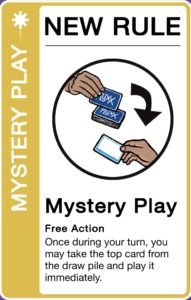
An example of how the rules are clearly written: because a key aspect of the rules is how many cards each player draws and plays per turn, this card (which allows players to draw and play 1 more card than the limit) specifically says that that card does not count towards the limit (“Free Action”)
- The cards are aesthetically pleasing. I got a lot of joy out of reading the title of the goal cards because they are creative names of the keeper cards they require.
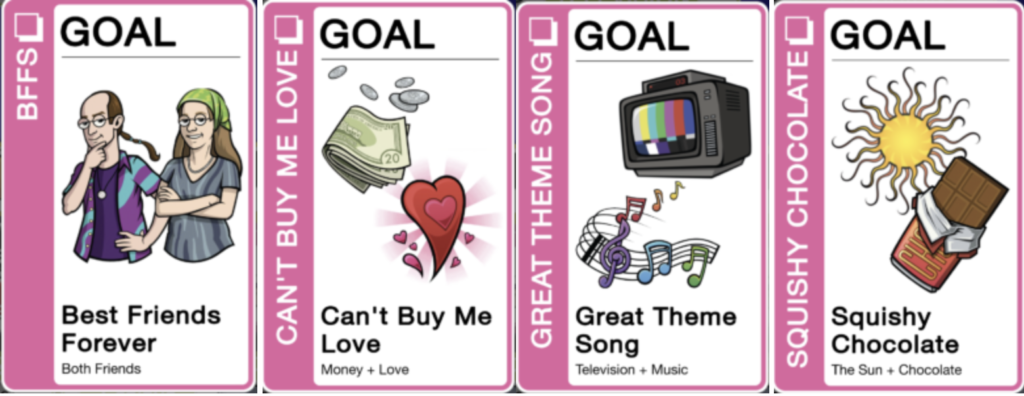
Some goal cards with fun names!
- The cards seem to be well-balanced — there are no / few cards that are overpowered and can give an unfair advantage to a player.
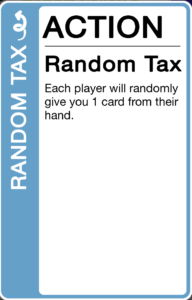
This card gives an advantage to the player who plays it in that it allows them to gain more cards immediately and increases the number of choices they can make. However, the game balances this with the fact that the player gets randomly chosen cards which might not be useful for their strategy.
- High replayability because of the large number of cards and changing rules.
- For the mobile game, very clear prompts about different options a player can take during their turn.
Left: I’m in my playing phase, but there is an option to use the “Mystery Play” rule card (which allows me to draw a card and play it immediately). It is difficult to see (hence why I need to circle it in red) but there is a highlighted border around that rule card, indicating that I can touch and pull it to the playing area to activate it.
Right: Similarly, now that I have a goal card, I can use the “Goal Mill” card that allows me to trade my goal cards with cards drawn from the draw pile. There is now a highlighted border around that rule card (and because I have used the “Mystery Play” rule card in this round, the highlighted border disappears.
What can be better:
- Unsure if this is part of the design, but there was no indication of the number of cards for each category, or whether there are duplicated cards (there are none). For new players, they may be frustrated because this can affect their ability to strategize.
- For e.g. if my opponent has one keeper card that matches the goal, but I know that the other keeper card is already discarded, I would not need to be worried if there are no duplicates because that missing keeper card will not show up again soon. I would still need to keep my defense up if there are duplicates since my opponent can get the duplicate keeper card next turn and win the game.)
- In the physical version, The instructions (both on the pamphlet and on the cards) can be more clear about replacing contradicting cards. The mobile game has clearer prompts for each step of the game, and the cards
- For my first game, we stacked all of the ‘draw’ cards (so each player would draw 1 from the base rule, then draw based on all ‘draw’ new rule cards that have been played, when we should have replaced the base rule with the new ‘draw’ cards, and then only have 1 ‘draw’ rule in play at any time.)
Overall, this will probably be one of my favorite physical games this year (and we’re only in February!). The changing rules means no game is the same, and players cannot min-max their strategies like with other games with fixed rules. These aspects provide a lot of joy and replayability!


